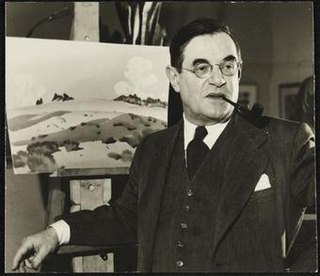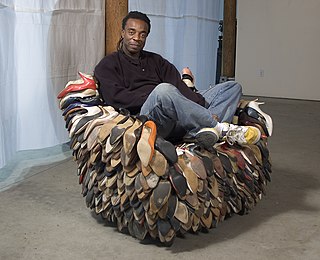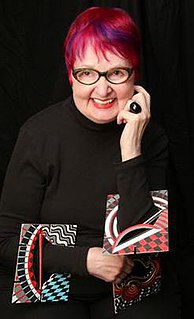This biography of a living person needs additional citations for verification .(May 2015) (Learn how and when to remove this template message) |

William C. Harper (born 1944) is an American jewelry artist known for studio craft jewelry.
This biography of a living person needs additional citations for verification .(May 2015) (Learn how and when to remove this template message) |

William C. Harper (born 1944) is an American jewelry artist known for studio craft jewelry.
Born in Bucyrus, Ohio, in 1944. He received a BS in 1966 and an MS in education in 1967, both from Case Western Reserve University in Cleveland, Ohio. He also studied advanced enameling techniques at the Cleveland Institute of Art. Harper began his career as an abstract painter but in the early 1960s switched to enameling. Many of his creations relate to mythology and ritual objects, and his work was included in the exhibition One of a Kind: The Studio Craft Movement at the Metropolitan Museum of Art in New York City, December 22, 2006-September 3, 2007.[ citation needed ]

Bucyrus is a city in the U.S. state of Ohio and the county seat of Crawford County, located in northern Ohio approximately 28 miles (45 km) west of Mansfield and 66 miles (106 km) southeast of Toledo. The population was 12,362 at the 2010 census. The city is the largest in Crawford County, and the center of the Bucyrus Micropolitan Statistical Area.

Case Western Reserve University is a private research university in Cleveland, Ohio. It was created in 1967 through the federation of two longstanding contiguous institutions: Western Reserve University, founded in 1826 and named for its location in the Connecticut Western Reserve, and Case Institute of Technology, founded in 1880 through the endowment of Leonard Case, Jr.. Time magazine described the merger as the creation of "Cleveland's Big-Leaguer" university.

The Cleveland Institute of Art, previously Cleveland School of Art, is a private college focused on art and design and located in Cleveland, Ohio.
Currently resides in New York City.
He should not be confused with the Afro-American sculptor and painter William A. Harper (1873–1910) or the American painter William St. John Harper (1851–1910).
Julian Stanczak was a Polish-born American painter and printmaker. The artist lived and worked in Seven Hills, Ohio with his wife, the sculptor Barbara Stanczak.

William Zorach was a Lithuanian-born American sculptor, painter, printmaker, and writer. He won the Logan Medal of the arts. He is notable for being at the forefront of American Artists embracing cubism, as well as for his sculpture.

Art jewelry is one of the names given to jewelry created by studio craftspeople. As the name suggests, art jewelry emphasizes creative expression and design, and is characterized by the use of a variety of materials, often commonplace or of low economic value. In this sense, it forms a counterbalance to the use of "precious materials" in conventional or fine jewelry, where the value of the object is tied to the value of the materials from which it is made. Art jewelry is related to studio craft in other media such as glass, wood, plastics and clay; it shares beliefs and values, education and training, circumstances of production, and networks of distribution and publicity with the wider field of studio craft. Art jewelry also has links to fine art and design.

Frank Nelson Wilcox was a modernist American artist and a master of watercolor. Wilcox is described as the "Dean of Cleveland School painters," though some sources give this appellation to Henry Keller or Frederick Gottwald.
Stanley Lechtzin is an American Jewelry and metals artist noted for his work in electroforming and Computer Aided Design and Computer Aided Manufacture.
Bruce Metcalf is an American artist who uses different materials including wood, metal, and plexiglass for his works. Metcalf is a supporter of new craftsmen and women's inventiveness in the absence of a degree in a hands-on trade.
Mary Lee Hu is an American artist, goldsmith, and college level educator known for using textile techniques to create intricate woven wire jewelry.
Kálmán Mátyás Béla Kubinyi was an influential etcher, engraver and enamelist and a member of the so-called Cleveland School, a number of relatively prominent artists in Northeast Ohio that existed from about 1910 to 1960.

Willie Cole is a noted contemporary American sculptor, printer, and conceptual and visual artist. His work uses contexts of postmodern eclecticism, and combines references and appropriation from African and African-American imagery. He also has used Dada’s readymades and Surrealism’s transformed objects, as well as icons of American pop culture or African and Asian masks.
Fritz Dreisbach is an American studio glass artist and teacher who is recognized as one of the pioneers of the American Studio Glass Movement.
Gary Lee Noffke is an American artist and metalsmith. Known for versatility and originality, he is a blacksmith, coppersmith, silversmith, goldsmith, and toolmaker. He has produced gold and silver hollowware, cutlery, jewelry, and forged steelware. Noffke is noted for his technical versatility, his pioneering research into hot forging, the introduction of new alloys, and his ability to both build on and challenge traditional techniques. He has been called the metalsmith's metalsmith, a pacesetter, and a maverick. He is also an educator who has mentored an entire generation of metalsmiths. He has received numerous awards and honors. He has exhibited internationally, and his work is represented in collections around the world.

John Paul Miller was an American jewellery designer and goldsmith, who also produced films, photographs and paintings. Stephen Harrison, decorative arts curator at the Cleveland Museum of Art, compares Miller's work with that of René Lalique and Louis Comfort Tiffany.

June Schwarcz was an American enamel artist who created tactile, expressive objects by applying technical mastery of her medium to vessel forms and plaques, which she considers non-functional sculpture.
Jamie Bennett is an American artist and educator known for his enamel jewelry. Over his forty-year career, Bennett has experimented with the centuries-old process of enameling, discovered new techniques of setting, and created new colors of enamel and a matte surfaces. This has led him to be referred to as “one of the most innovative and accomplished enamellers of our time” by Ursula Ilse-Neuman, historian and former curator at the Museum of Art and Design in New York City. Bennett is closely associated with the State University of New York at New Paltz, where he studied himself as a student, and taught in the Metal department for many years. Bennett retired from teaching in 2014, after thirty years at SUNY New Paltz.
Karl Joseph Maria Drerup was a leading figure in the mid-twentieth-century American enamels field. Trained as a painter, Drerup taught himself to enamel in the early 1940s, fusing glass to metal through a high-temperature firing process. Through his inventive, "painterly" approach to the medium, he advanced enameling to new levels of beauty, power, and expressiveness. Drerup's love of nature is apparent in every detail of his intimate woodland scenes, just as his depictions of humble workers in natural settings reveal his profound respect for humanity. A modest, self-deprecating individual, he exerted an enormous impact on the generation of enamel artists that emerged in the United States in the period immediately following World War II.
Myra Mimlitsch-Gray is an American metalsmith, artist, critic, and educator living and working in Stone Ridge, New York. Mimlitsch-Gray's work has been shown nationally at such venues as the John Michael Kohler Arts Center, Museum of the City of New York, Metropolitan Museum of Art, Cooper-Hewitt Smithsonian Design Museum, and Museum of Arts and Design. Her work has shown internationally at such venues as the Middlesbrough Institute of Modern Art, Stadtisches Museum Gottingen, and the Victoria and Albert Museum, and is held in public and private collections in the U.S, Europe, and Asia.
Jack Earl is an American ceramic artist and former teacher, known for drawing inspiration from his home state of Ohio to create rural pieces “with meticulous craftsmanship and astute details… to where you could smell the air, hear the silence and swat the flies.” Although his works hint at highly personal, intellectual, and narrative themes in an almost unsettling manner, Earl is “a self-described anti-intellectual who shuns the art world." He is known particularly for using his trademark format, the dos-a-dos : “This art form is like a book with two stories… the two seemingly incongruent images prompt the viewer to fill in the conceptual gap through poetic speculation.” His work often involves dogs or the character “Bill”, who is said to be a combination of Earl’s father-in-law, himself, and others. The titles to his pieces are typically lengthy, stream-of-consciousness narratives that suggest the folk or rural lifestyle. These are intended to add another dimension to the artwork. His work has received a notable response over his decades-long career, especially since he is regarded as “a master at reminding us that within the events we take for granted are moments of never-ending mystery and wonder.” Earl continues to live in Lakeview, Ohio with his wife, Fairlie.
Jason Lloyd Schoener was an American painter and teacher.

Marjorie Schick was an innovative American jewelry artist and academic who taught art for 50 years. Approaching sculptural creations, her avant-garde pieces have been widely collected. Her works form part of the permanent collections of many of the world's leading art museums, including the Hermitage Museum in Saint Petersburg, Russia; the Museum of Arts and Design in New York City; the National Museum of Modern Art in Kyoto, Japan; the Philadelphia Museum of Art in Pennsylvania; and the Victoria and Albert Museum of London.
Kennedy Galleries is one of the oldest art galleries in the United States. It was founded by Hermann Wunderlich in 1874 under the name of Hermann Wunderlich & Co. When Wunderlich died in 1892, Edward G. Kennedy took over the gallery, whose name was changed in 1912 to Kennedy & Co. Kennedy retired in 1916, whereupon Herman Wunderlich became the gallery's senior partner until his death in 1951. The galleries changed their name to Kennedy Galleries in 1952. The gallery has long specialized in representational art.